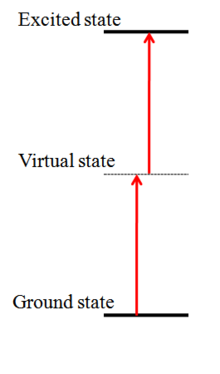
Back امتصاص فوتونين Arabic İkifotonlu udulma Azerbaijani Absorció de dos fotons Catalan Zwei-Photonen-Absorption German Absorción de dos fotones Spanish Absorption à deux photons French בליעה דו פוטונית HE Assorbimento a due fotoni Italian 2光子吸収過程 Japanese Absorção de dois fótons Portuguese

In atomic physics, two-photon absorption (TPA or 2PA), also called two-photon excitation or non-linear absorption, is the simultaneous absorption of two photons of identical or different frequencies in order to excite an atom or a molecule from one state (usually the ground state), via a virtual energy level, to a higher energy, most commonly an excited electronic state. Absorption of two photons with the same frequency is called degenerate two-photon absorption, while absorption of two photons with different frequencies is called non-degenerate two-photon absorption. The energy difference between the involved lower and upper states is equal or smaller than the sum of the photon energies of the two photons absorbed.
Since TPA depends on the simultaneous absorption of two photons, the probability of two-photon absorption is proportional to the photon dose (D), which is proportional to the square of the light intensity D ∝ I2 thus it is a nonlinear optical process.[1] Two-photon absorption is a third-order process, with absorption cross section typically several orders of magnitude smaller than one-photon absorption cross section.
Two-photon absorption was originally predicted by Maria Goeppert-Mayer in 1931 in her doctoral dissertation.[2] Thirty years later, the invention of the laser permitted the first experimental verification of two-photon absorption when two-photon-excited fluorescence was detected in a europium-doped crystal.[3] Soon afterwards, the effect was observed in cesium vapor and then in cadmium sulfide, a semiconductor.[4][5]
- ^ Tkachenko, Nikolai V. (2006). "Appendix C. Two photon absorption". Optical Spectroscopy: Methods and Instrumentations. Elsevier. p. 293. ISBN 978-0-08-046172-4.
- ^ Goeppert-Mayer M (1931). "Über Elementarakte mit zwei Quantensprüngen". Annals of Physics. 9 (3): 273–95. Bibcode:1931AnP...401..273G. doi:10.1002/andp.19314010303.
- ^ Kaiser, W.; Garrett, C. G. B. (1961). "Two-Photon Excitation in CaF2:Eu2+". Physical Review Letters. 7 (6): 229. Bibcode:1961PhRvL...7..229K. doi:10.1103/PhysRevLett.7.229.
- ^ Abella, I.D. (1962). "Optical double-quantum absorption in cesium vapor". Physical Review Letters. 9 (11): 453. Bibcode:1962PhRvL...9..453A. doi:10.1103/physrevlett.9.453.
- ^ Braunstein, R.; Ockman, N. (20 April 1964). "Optical Double-Photon Absorption in CdS". Physical Review. 134 (2A): A499. Bibcode:1964PhRv..134..499B. doi:10.1103/PhysRev.134.A499.